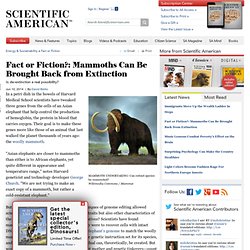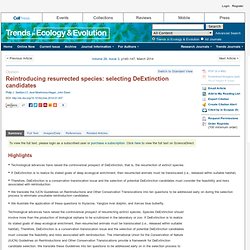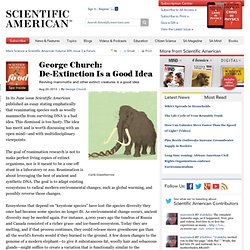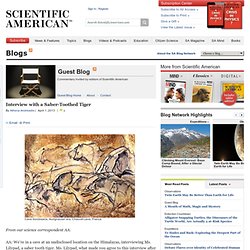

Fact or Fiction?: Mammoths Can Be Brought Back from Extinction. In a petri dish in the bowels of Harvard Medical School scientists have tweaked three genes from the cells of an Asian elephant that help control the production of hemoglobin, the protein in blood that carries oxygen.

Their goal is to make these genes more like those of an animal that last walked the planet thousands of years ago: the woolly mammoth. Trends in Ecology and Evolution - Reintroducing resurrected species: selecting DeExtinction candidates. To view the full text, please login as a subscribed user or purchase a subscription.

Click here to view the full text on ScienceDirect. Highlights •Technological advances have raised the controversial prospect of DeExtinction, that is, the resurrection of extinct species. •If DeExtinction is to realize its stated goals of deep ecological enrichment, then resurrected animals must be translocated (i.e., released within suitable habitat)•Therefore, DeExtinction is a conservation translocation issue and the selection of potential DeExtinction candidates must consider the feasibility and risks associated with reintroduction.
•We translate the IUCN Guidelines on Reintroductions and Other Conservation Translocations into ten questions to be addressed early on during the selection process to eliminate unsuitable reintroduction candidates. Technological advances have raised the controversial prospect of resurrecting extinct species. To access this article, please choose from the options below. George Church: De-Extinction Is a Good Idea. In its June issue Scientific American published an essay stating emphatically that reanimating species such as woolly mammoths from surviving DNA is a bad idea.

This dismissal is too hasty. The idea has merit and is worth discussing with an open mind—and with multidisciplinary viewpoints. The goal of reanimation research is not to make perfect living copies of extinct organisms, nor is it meant to be a one-off stunt in a laboratory or zoo. Reanimation is about leveraging the best of ancient and synthetic DNA.
The goal is to adapt existing ecosystems to radical modern environmental changes, such as global warming, and possibly reverse those changes. Ecosystems that depend on “keystone species” have lost the species diversity they once had because some species no longer fit. “De-extinction” is not a novel idea. Aside from bringing back extinct species, reanimation could help living ones by restoring lost genetic diversity. Big Animal Extinction Impoverishes Soil: Scientific American Podcast. Ecosystems still feel the pain of ancient extinctions - life - 11 August 2013. The four million year odyssey of the horse : Gene Expression. The horse is a beautiful animal.* That is not a trivial matter, but there is the added fact that historically it is has been of great consequence.

Obviously the rise of horses as vehicles of war is preeminent in our minds, but on a more prosaic level draft horses revolutionized many societies via their effect on agricultural productivity. Dogs may be man’s best friend, but horses are arguably** man’s most useful friend. Or at least they were. The critical importance of the horse is probably lost on modern people, but until the rise of the automobile they were ubiquitous in many large cities (this is clear when you view early films).
Today horses are perceived to be luxurious playthings (ergo, the term “horse country”), but during the heyday of the horse-powered world they served the roles of tractors, tanks, automobiles, and telegraphs. Oldest animal genome is sequenced from horse bone - life - 26 June 2013. Laws Lag Behind Science in De-Extinction Debate : The Crux. By Virginia Gewin The passenger pigeon is one animal being discussed for de-extinction.

Image courtesy National Park Service. Chuck Bonham, director of the California Department of Fish and Wildlife, is no stranger to potentially controversial species restoration plans: His agency will soon poison non-native fish in an effort to re-establish the Paiute cutthroat trout to its historic range. Still, the practicalities of efforts to revive extinct species raised mixed emotions among Bonham and participants at the “De-Extinction: Ethics, Law and Politics” conference held at the Stanford Law Auditorium last Friday. Addressing the scientists in the audience, Bonham (who made clear he wasn’t speaking for the agency) said he and colleagues were “scared, worried, thrilled, excited, and angry at you guys for exploring this idea.” Why Efforts to Bring Extinct Species Back from the Dead Miss the Point. Interview with a Saber-Toothed Tiger. Cave lion(esse)s, Aurignacian era; Chauvet cave, France From our science correspondent AA.

AA: We’re in a cave at an undisclosed location on the Himalayas, interviewing Ms. Lilypad, a saber tooth tiger. Ms. Doit-on ressusciter les espèces disparues ? Avez-vous entendu parler de Rheobatrachus silus ?

Si la réponse est non, il n’y a rien d’étonnant car cette espèce australienne de grenouille, connue en français sous le nom de grenouille plate à incubation gastrique, est considérée comme éteinte depuis 1983, date à laquelle le dernier spécimen conservé en captivité est mort. L’animal s’avère pourtant fascinant, pour deux raisons. La première tient à son mode d’incubation très particulier : une fois qu’elle avait pondu, la femelle avalait ses œufs et les tenait à l’abri dans son estomac où ils grandissaient durant environ un mois et demi.
Pendant toute cette période, la grenouille ne mangeait pas et son estomac cessait de produire de l’acide chlorhydrique qui, autrement, aurait dissous les œufs. Enfin, la grenouille accouchait… par la bouche. La seconde raison, pour laquelle on reparle de Rheobatrachus silus aujourd’hui, s’appelle le projet Lazare (comme le Lazare que Jésus ressuscite dans le Nouveau Testament).